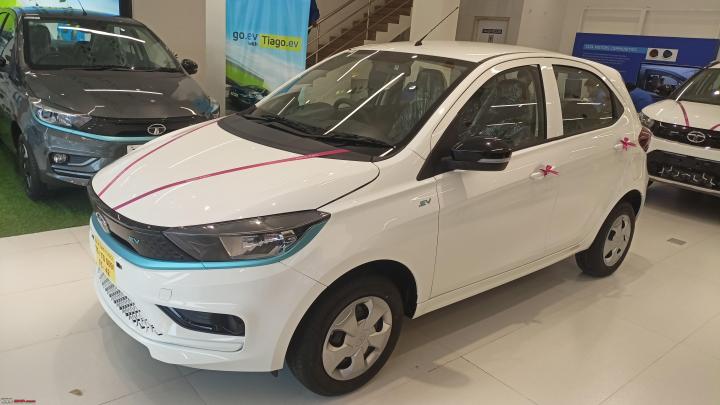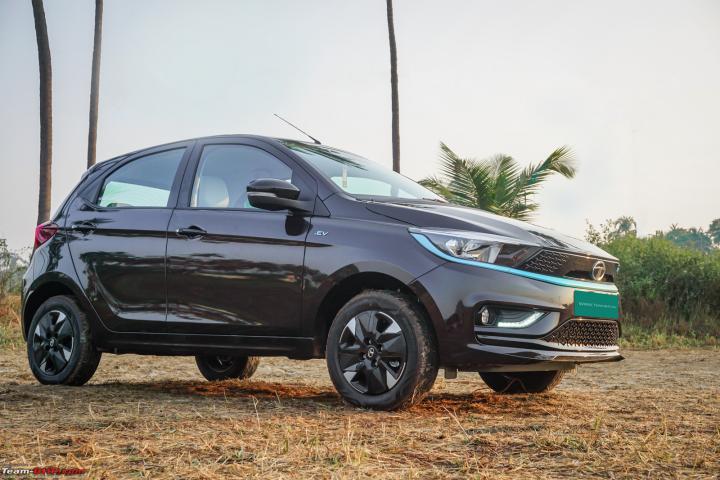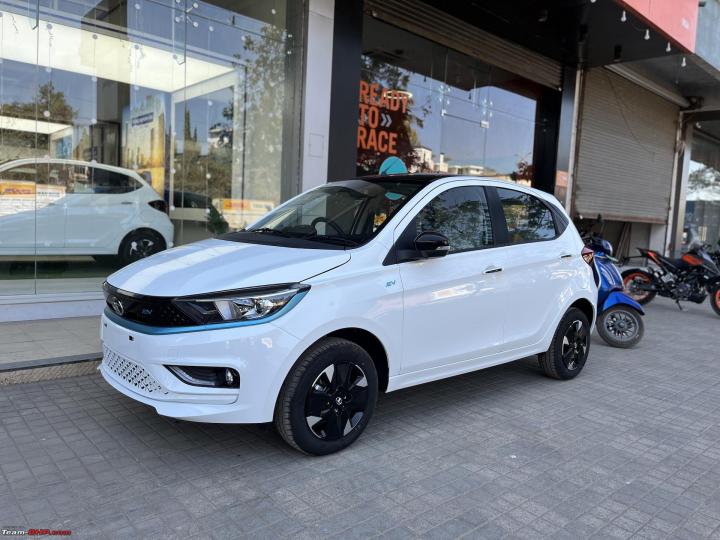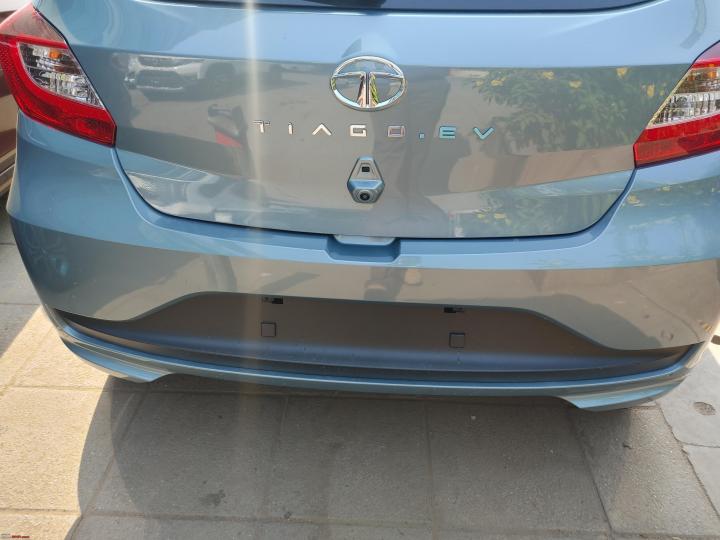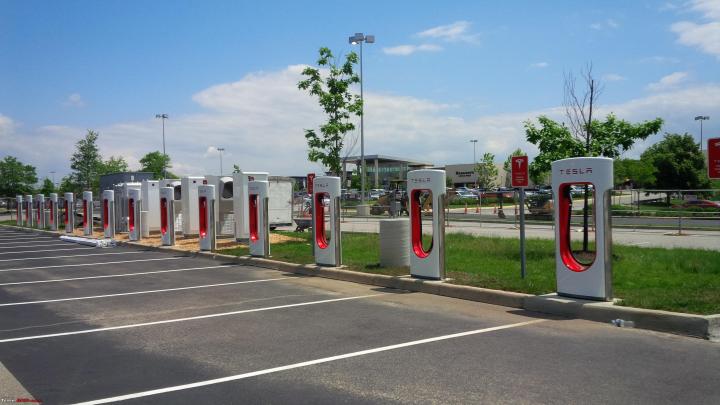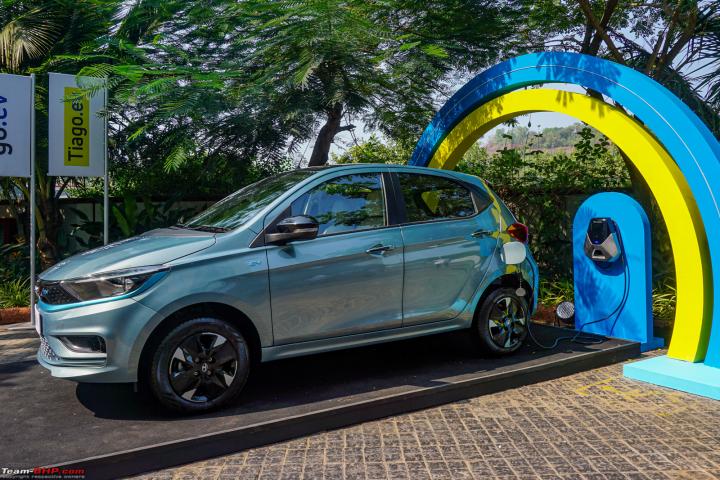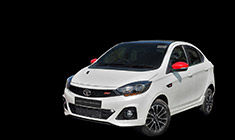News
Brought home my Tiago EV XT Long range: Initial impressions
Coming to driving the Tiago EV, it's butter smooth and I'm virtually driving on single pedal with regen modes adjusted according to traffic.
BHPian Aishven recently shared this with other enthusiasts.
Hello all, happy to share that I received my Tiago ev XT LR on 27th Feb. 3kw Charger is installed on 3rd March. Driven 214 km do far all in city. So far it's been a very exciting and proud experience. My wife loves the car. Apartment residents, colleagues and even strangers admired the car and asked hell lot of questions. They even asked for a spin around.
On delivery day ODO was on 26 km. First day on hundred percent charge it displayed 170 kms of range. With 100% battery left it covered 157 km. I was worried. When I charged it to 100% with 3kw charger it displayed 230 km with 3 level regen. Today I covered 32km with 22 percent battery usage. Was using AC all times and even stopped for 20 minutes with AC running for an ice-cream.
Coming to driving Tiago EV, it's butter smooth and I'm virtually driving on single pedal with regen modes adjusted according to traffic.
Loving the attention it's grabbing now. Will post more updates in coming days.
Read BHPian comments for more insights and information.
- Tags:
- Indian
- tata tiago ev
News
Tata Tiago EV: An Ecosport owner's impressions post test drive
Overall, I am impressed with the drivetrain and pricing. Has the potential to be the perfect city car.
BHPian qaqa recently shared this with other enthusiasts.
I did a longish test drive of the Tiago EV today. The test drive car was the top-end long-range variant.
As others have commented, D mode is decent in city traffic. S mode is very peppy. The test drive had four adults on board and I did not feel a lack of power at any time. I took the car around the deserted Mysore ring-road, and was pleasantly surprised with how quickly the 80KMPH mark came up on S mode with a full load of 4 adults on-board. This car is definitely peppier than my Ecosport Dragon AT and can be neck and neck with my Tucson Diesel up to 80KMPH. I even pushed the car to 100kmph on a deserted stretch, and it didn't take long to reach the ton at all!
The car handled bad roads quite well. Bump absorption was good with relatively little being transmitted to the cabin. A world apart from the bumpy Ecosport that I am so used to.
The car is nice and chuckable - the turning radius is really good. I ended up taking U-turns for fun on the test drive
I tried starting the car on an incline to check roll-back. In S mode, it rolled back maybe 2 inches at most before surging forward. Didn't look like a deal-breaker at all.
Some issues which I noticed -
- The indicated range fell from ~150km to ~110km at the end of a 15km test drive in S mode. Hope the software to estimate range is fine-tuned in the coming days.
- The front seats are have a weird shape to it - just couldn't get comfortable with it. Lumbar support was somewhat weird for me.
- The rear seat-back is really short with fixed headrests. Not a comfortable bench for taller folk
- The rear seat-back wasn't folding fully for some reason. Not sure if this was an issue with the test drive car.
- Poor fit and finish visible in a couple of places. For example, the plastic panel in front of the gear selector was roughly finished with uneven edges. Looked like the part had skipped the final finishing process entirely. The fabric in the boot was poorly put-together.
Overall, I am impressed with the drive-train and pricing. Has the potential to be the perfect city car. Hope that the legendary Tata QC doesn't let the car down.
Read BHPian comments for more insights and information.
- Tags:
- Indian
- tata tiago ev
News
One week with my Tata Tiago EV: 5 quick observations including range
On 100% charge have got a range of 180 km with almost 100% air conditioner being on and another time have got 195 km.
BHPian Mile10 recently shared this with other enthusiasts.
After having driven the Tiago EV for a week, these are my observations.
- Amazing city car, steering is light, turning radius is great and is a breeze to drive within the city. My left foot was very happy last evening after having driven over 100 kms in peak bangalore traffic the whole day.
- Regen works well, it is great for crawling traffic and it is possible to do single pedal driving. Only issue is everytime the car is switched on it starts from level 1 as default, even if you had switched off the car from the previous drive at level 3, need to check the manual if there is a way to change the default startup setting for Regen level.
- I have driven almost 400 Kms in a week. On 100% charge have got a range of 180Kms with almost 100% air conditioner being on and another time have got 195Kms, all of this in peak bangalore traffic. (dropping kids to school, office commute on ORR)
- The auto headlamps feature works great, it is a great feature to have in basement parkings, underpass etc. It works flawlessly.
- The white Premium Leatherette Seat Upholstery gets soiled very easily though it is quite easy to clean and looks good, it needs regular maintenance.

Read BHPian comments for more insights and information.
- Tags:
- Indian
- tata tiago ev
News
Brought home my Tata Tiago EV XZ+ Tech Lux: 5 quick observations
There's going to be a bit of learning curve to extend the driveable range and the use of regeneration levels.
BHPian sumithb recently shared this with other enthusiasts.
Took delivery of Tiago EV XZ+ Tech Lux today with 30 KMs on the ODO, now it stands at ~70 KMs.
Did not buy any accessories from the dealership, planning to get Floor Mats and Mud Guards. Do let me know if anyone has recommendations on good Floor Mats and any other must have accessory for an EV.
Impressions so far:
- The NVH is decent, there's some Tyre Noise and I found the AC blower to be loud. Need to check if the Tyre is overinflated.
- The pickup is adequate for a city car in the 'Drive' mode, haven't tried the 'Sports' mode yet.
- The car does roll back ever so slightly on an incline when switching from brake to accelerator. Nothing alarming but use of handbrake will be prudent.
- There's going to be a bit of learning curve to extend the drivable range and the use of regeneration levels.
- Before today, my only other experience driving an EV was the short test drive of Nexon EV last year. Overall happy with the purchase.
Now for some pictures


Read BHPian comments for more insights and information.
- Tags:
- Indian
- tata tiago ev
News
Tata Tiago EV: Tata Dealer refuses to install electrical accessories
I'm specifically looking to get the rear parking sensors installed as the XZ+ Tech does not come with Reverse Park Assist
BHPian Mile10 recently shared this with other enthusiasts.
Just checked with my dealer, apparently you can't install any electrical accessories on the EV Car as it will impact warranty. I'm specifically looking to get the rear parking sensors installed as the XZ+ Tech does not come with Reverse Park Assist Audible Sensors; it comes installed only with the Camera. Surprised that Tata decided to offer only the camera on the top end variants.
Here's what BHPian coldice4u had to say on the matter:
I believe this is understandable. Considering most of the issues reported for Nexon and Tigor have been electrical in nature, i would be very wary of any kind of accessories. I myself wanted to get a dashcam and HIDs for the car, but i guess I'll hold off.
Also has anyone here got a car delivered?
Here's what BHPian Shreyans_Jain had to say on the matter:
Dealers will always say that, they just want that you buy the accessories from them at FAT margins.
The 12v electrical system that runs the lights, indicators, reversing camera etc is the same as the regular petrol Tiago, or any other car. You can install any accessory like reversing camera or dashcam safety as long as proper connectors are used and wiring is not cut.
Here's what BHPian guptad42 had to say on the matter:
This looks like fake fear mongering to me. Yes, I understand we are (and should be) vary of tinkering with the LFP EV battery electrical system.
But, like most EVs, tiago.ev also has an additional, ordinary 12V Lead acid battery for accessories and headlamps etc. So, it should be possible to install the usual electrical accessories without touching the main EV battery and motor driving electrical systems at all.
Read BHPian comments for more insights and information.
- Tags:
- Indian
- tata tiago ev
News
Why I am looking forward to my Tiago EV delivery after a test drive
The torque numbers don't tell the whole story. The car is very pleasing to drive with sufficient power on tap, never once did it feel underpowered.
BHPian crazydevil recently shared this with other enthusiasts.
Had a quick spin today, the TD vehicle was a spanking new XZ+ tech Lux in Tropical Mist. Barely 40 km on the odo. Few quick observations:
- Tropical Mist is GORGEOUS, very pleasing on the eye, and one of the few Tata EV colors where the blue EV bits don't really look out of place.
- Can confirm that there are no reverse parking sensors. However the camera has dynamic guidelines.
- The pole type antenna is an eyesore.
- The hyperstyle wheel covers look little overdone. I was told that they are interchangeable with the Tigor EV covers, which have a less busy design.
- Roads in my city are mostly flat, but I tried the roll-back on the slope of a flyover. I found it good enough, not at all a deal breaker.
- The torque numbers don't tell the whole story. The car is very pleasing to drive with sufficient power on tap, never once did it feel underpowered. Ofcourse, being inside the city, I did not go over 80 kmph. But this is meant to be a city car after all, and it should do that job wonderfully.
- No traction control = wheelspin in S mode. May end up wearing out the tyres early.
- A transparent plastic clip-bit on the windshield towards the driver side caught my attention, apparently Tata is providing such clips to hold parking tickets / toll receipt etc. Nice touch!
The sales exec said that Tata is prioritizing deliveries of the top end variants. He told me to expect the delivery at the end of this month. Looking forward to it!
Some pics:
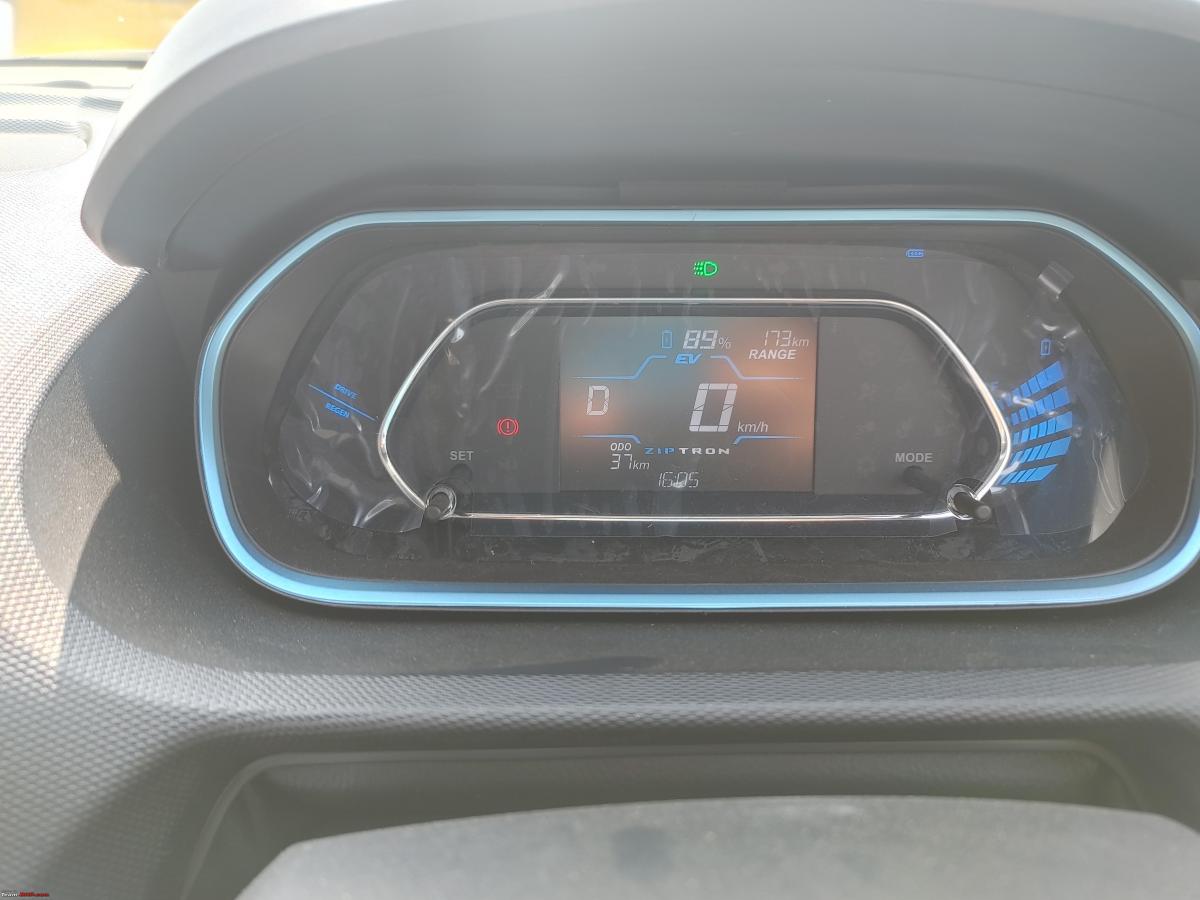
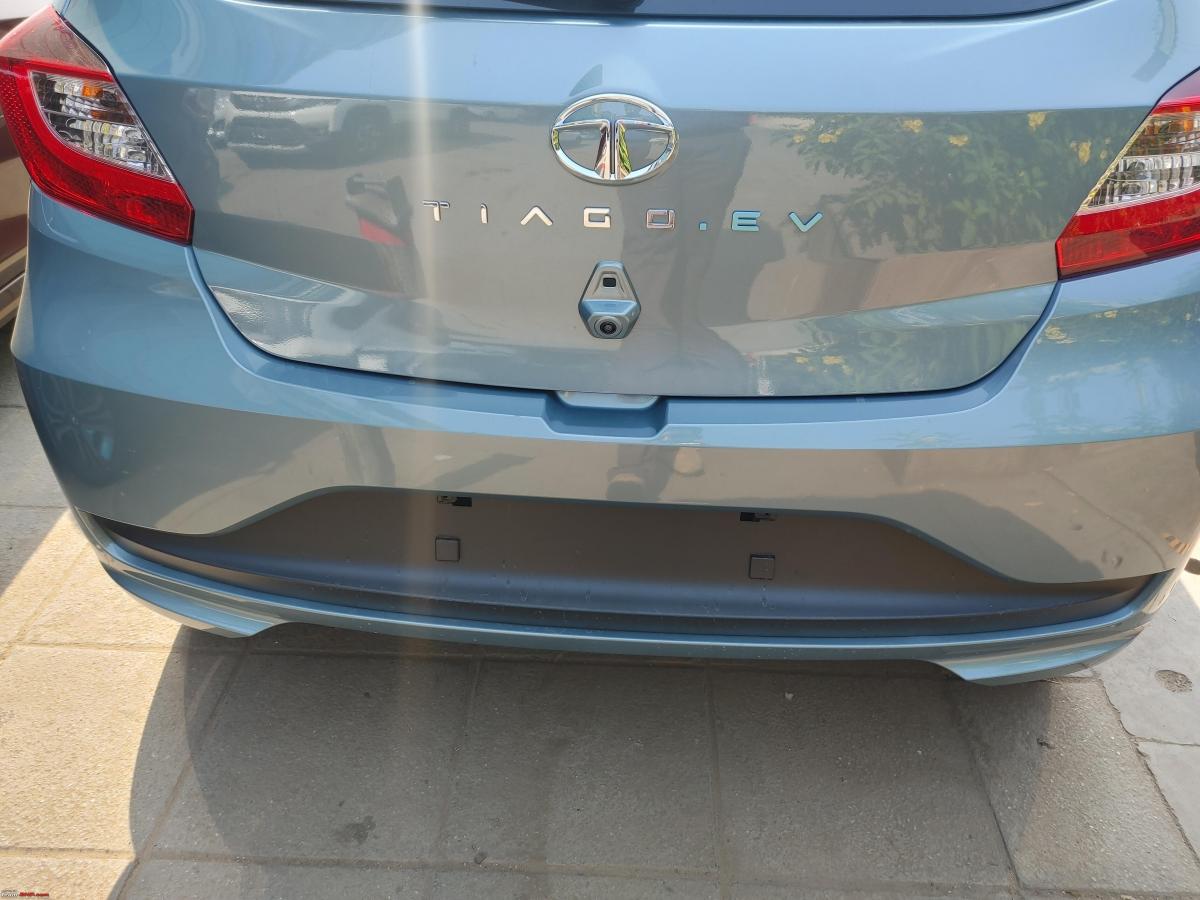
Check out BHPian comments for more insights and information.
- Tags:
- Indian
- Tata
- tata tiago ev
- EV
- electric cars
News
Tata Tiago EV: 5 observations after a test drive in Bangalore traffic
Overall It seems like a perfect city package and I'm eagerly waiting for delivery of my vehicle.
BHPian Mile10 recently shared this with other enthusiasts.
I got to test drive the Tiago EV at KHT Whitefield today. Below are my observations:
- The car is really peppy in S mode and I feel the power on tap is more than sufficient for city traffic. 0 to 60 performance was good in the crowded Whitefield roads.
- Very easy to drive and sorted road manners (Driving the Crysta from the showroom to home after having driven the Tiago EV was cumbersome in evening rush hour!)
- Tested the roll back at the KHT showroom basement parking where they park all their test drive cars, and I must say the rollback is not a deal breaker like I thought it would be. There is some amount of rollback in D Mode, but very much manageable in S Mode. Tight spots in traffic though I recommend to use the handbrake.
- The selective regenerative braking is awesome, and you can see the real time range increasing depending on the level of regen you choose!
- The 8 speaker audio system is good, though the touchscreen in the test drive car had a bit of lag. Not sure if it needed a software update to improve the performance. Hope Tata sorts that out.
Overall It seems like a perfect city package and I'm eagerly waiting for delivery of my vehicle.
Read BHPian comments for more insights and information.
- Tags:
- Indian
- tata tiago ev
News
My harrowing experience booking a Tata Tiago EV online
I've owned Toyota, VW and Audi till now and never have I experienced such inferior customer service.
BHPian anshumandun recently shared this with other enthusiasts.
Another horrible booking experience:
I booked on 10th Oct at 12:30pm. Money got deducted and I got an email from Razor Pay that Rs 21,000 has been paid to Prerana Motors (Yelahank Branch).
I visited Yelahanka showroom (Bangalore) and met a sales person there named Mr. Manoj. He assured me that booking will be confirmed in a few days. For the next one month, the standard response was "we will update you soon".
After one month, I lost patience and went to showroom again and this time got introduced to Mr. Ranjith. He again assured me that within one week booking will be confirmed. It has again been almost a month now and no booking confirmation.
The worst experience: Both the sales people (Manoj and Ranjith) have stopped responding to me on calls and whatsapp since 2-3 weeks. They don't take my calls and don't reply on whatsapp. I've owned Toyota, VW and Audi till now and never have I experienced such inferior customer service.
I am 99% sure that I don't want to go ahead with the purchase. This might be a great product but with such poor customer service in the starting, I can only imagine what I might have to go through during service and repairs.
After I lost patience waiting for the sales executives to respond, I sent out several emails to the dealership including to their director (found email id on internet). Within 30 minutes, I started getting calls from various people from Prerana Motors and by evening they sent me a booking receipt.
Update
Today, I got an email from Tata Motors confirming my Tiago booking.
Unexpectedly quick resolution! Although I am still in a dilemma if I should go ahead with a Tata car or not.
Read BHPian comments for more insights and information.
- Tags:
- Indian
- tata tiago ev
News
Should Tata Motors establish a Tesla-like supercharger network for EVs?
I counted 819 DC connectors/plugs per TATA Power website as of December, 2022.
BHPian vtires2018 recently shared this with other enthusiasts.
Should TATA Motors make supercharger stalls like TESLA?
- TATA Motors owns largest share of EV market in India, more than 84%.
- Tesla was also owned largest EV share in North America. Then they opened Tesla Super Charger Network. The result is for all of us to see. Tesla is now a dominant player in EVs leaps ahead of GM, FORD, Toyota, Honda, Hyundai etc
From the below graphic ( numbers may have increased*):
- Tesla has now* more than 4000 Super charger stations
- Tesla has now* more than 38,000 Super charger Connectors/DC fast charging plugs.
Should Tata with growing EV sales help their customers and growing EV eco system by developing EV sites/like fuel stations, and powering them with EV DC and "AC" fast chargers ?
Please comment, what is the maximum DC and AC fast charging your EV cars can "charge with".
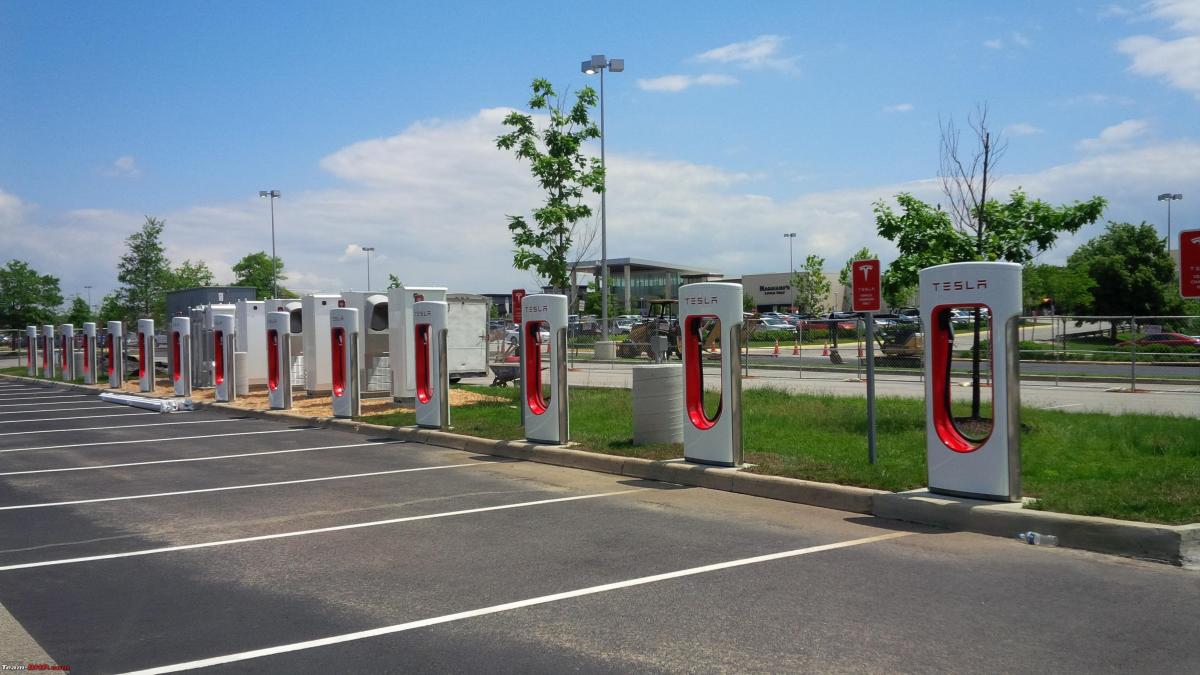
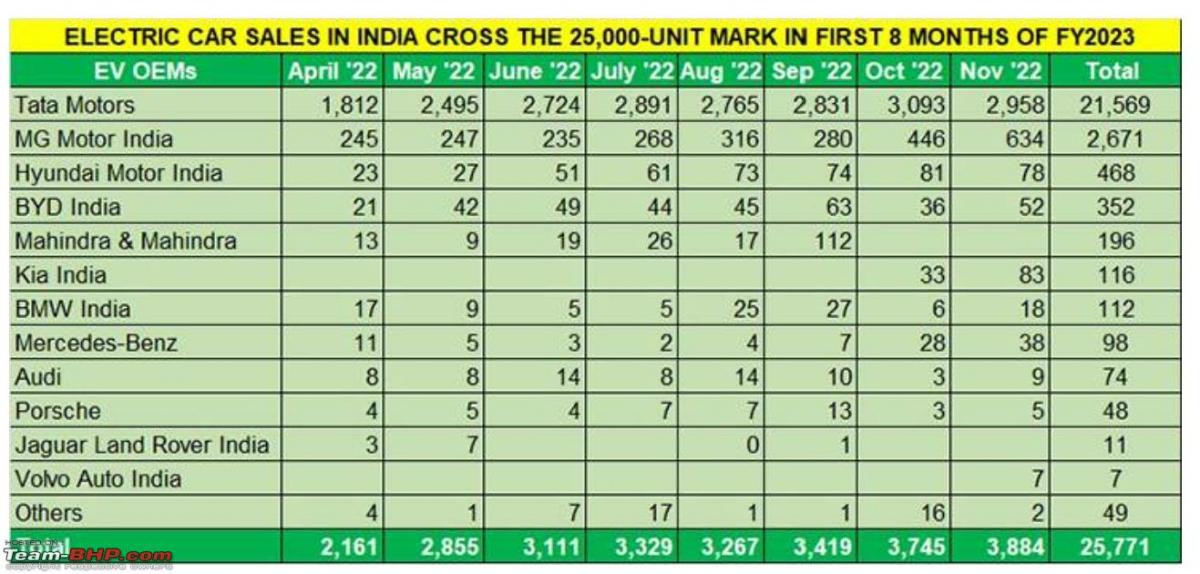
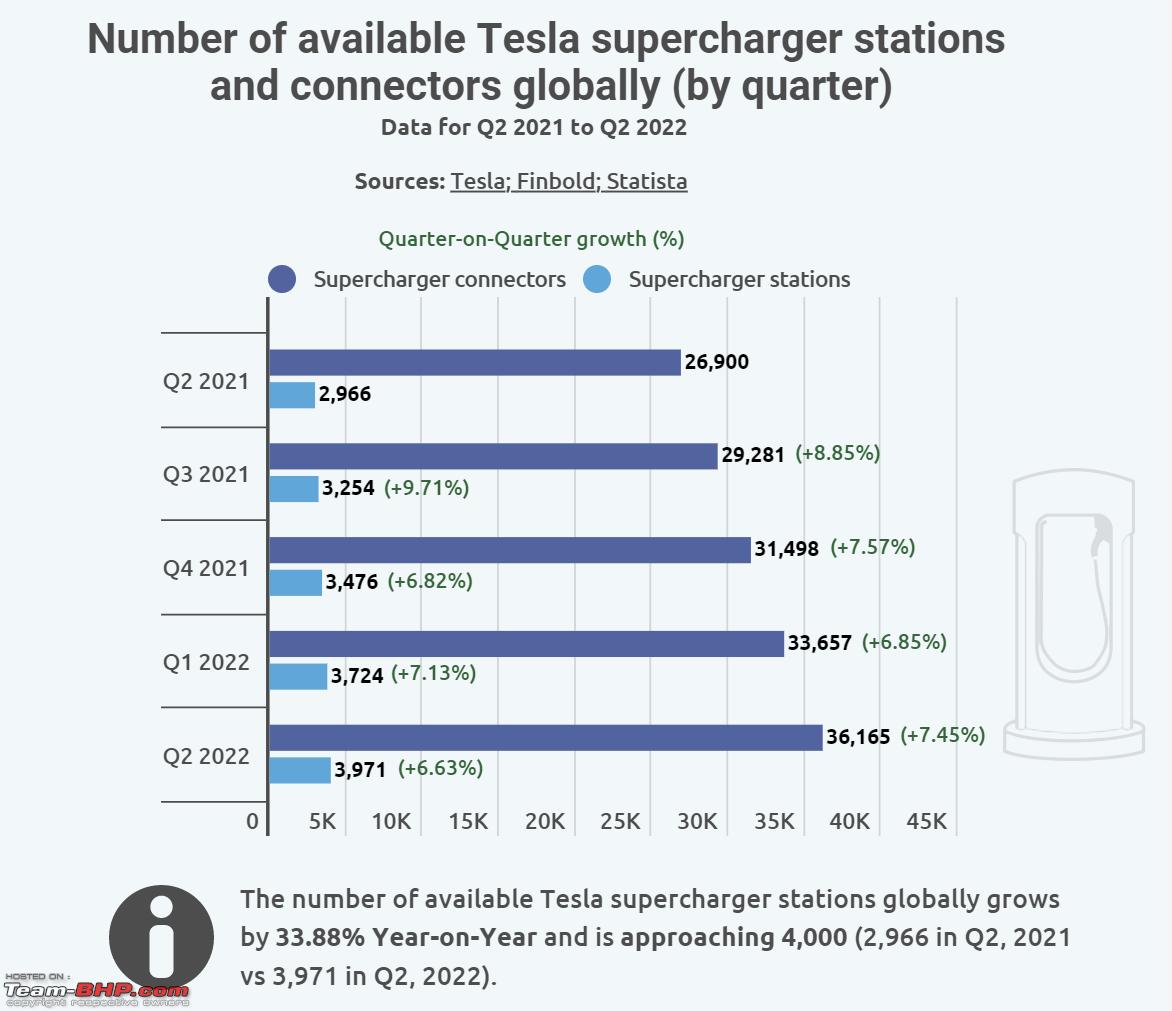
Counted 819 DC only connectors/plugs per TATA Power website as of Dec 2022.
Tata has sold around 21,500 EV's so far (not sure of this number)
But main question is - Tesla has been opening the DC chargers around the highways, suburbs, parking spaces, etc.
- Is Tata (or other EV Car seller) also following that approach ? They is a need to open more AC and DC chargers (dedicated spaces ) possibly away from busy areas. ( like a dedicated EV parking lots) 5 -10 KM before entering any city (all tiers)
- Or are they opening only in dealerships with motivation of increasing sales ?
- Also question is how many are actually functional ?

Here's what BHPian Lina had to say on the matter:
Before setting up "Super"Chargers, Tata needs to make EVs that can be used on the highway comfortably. Currently all of Tatas cars charge at abysmal rates. The EV-max which is the fastest charges at 30kW. This basically translates to about 100km of range added in 30 min of charging if you drive <100kmph. So, if you drive at 90kmph for an hour, you will have to stop for 30 min to get back that range. The regular Nexon (21kW) and Tigor (18kW) have much worse stats in this regard. If you compare this with the ZS EV, it can add about 175km in 30 min. Not great but a lot more liveable.
Now, coming to the chargers installed, Tata chargers are usually slow, unreliable and at inconvenient locations. Networks like Zeon and Relux make it a point to install faster, more reliable chargers at restaurants on the highway making the whole process more seamless. As far as I am concerned, apart from Tesla, no other company has bothered about the charging network and how it works with the car. Tesla also routes the drivers to specific charger.
Here's what BHPian Tucker48 had to say on the matter:
Indian govt has set some standards for battery and charging infrastructure which the industry is opposing as they say it will stifle innovation.
Why would a for profit company will install chargers on a large scale when it's going to be used by competition as well. I don't know cost economics of chargers but IMO, it won't be profitable in metros unless govt agencies give land.
And, Tesla is losing market share faster than anyone ever predicted. Plus the federal incentives 2022 aren't of much help either. Only one model falls under $55000 limit (correct me if I'm wrong)
So, IMO, these tasks should be taken over by the govt if they want it to be standardized.
Here's what BHPian guptad42 had to say on the matter:
Make AC slow charging in 7-20KW range common.
1. Tata/all electric car sellers in India should first make 7.2 KW level 2 AC home charger standard across the range. They can work with the charger manufacturers for cheaper designs. The rising volumes will also reduce costs. 3.3KW is just too slow and should not be used on 4 wheelers.
2. Tata Power and other charging networks can work with commercial parking spaces like malls, large offices, and also with residential buildings to install 11-20KW AC chargers in 5% of parking spots. The %age of parking lots with charging can be increased gradually over the years. Initial selection of spots for charging can be based on surveys of people who frequent the place, and EV sales trends in the catchment area. Avoid DC fast charging in covered areas, as long term safety could be a problem due to lack of maintenance.
For highway chargers, focus the investment to provide the best experience to most EV owners. Instead of a slow and poor experience everywhere. This is critical to sharply raise confidence in buying new EVs.
3. DC fast chargers on roads leading out from the top car buying cities to nearby cities and towns up to 500km range. EV charging stops at 30 minutes travel distance at highway speeds. So about 40km apart.
4. While western countries are going to 300-550KW DC fast charging or more, India should standardise on minimum 100 or 150 KW for DC fast charging. Peak charging rate in any car should not be less 2C. That'll allow adding 100-250km range in a brief chai/coffee stop, depending upon battery size. At that point, people will worry less about charging times and range anxiety.
Read BHPian comments for more insights and information.
News
Tata Tiago Electric: Our observations after a day of driving
If you’re wondering, how it compares to the Tigor EV with the torque deficit, don’t worry. The Tiago EV feels very similar to drive due to the lower kerb weight (86 kg lighter) and the tuning of the motor.
Driving the Tata Tiago EV
The car that we got to drive was the long-range variant with the 24kWh battery pack. It has a Permanent Magnet Synchronous Motor that puts out 74 BHP & 114 Nm of torque:
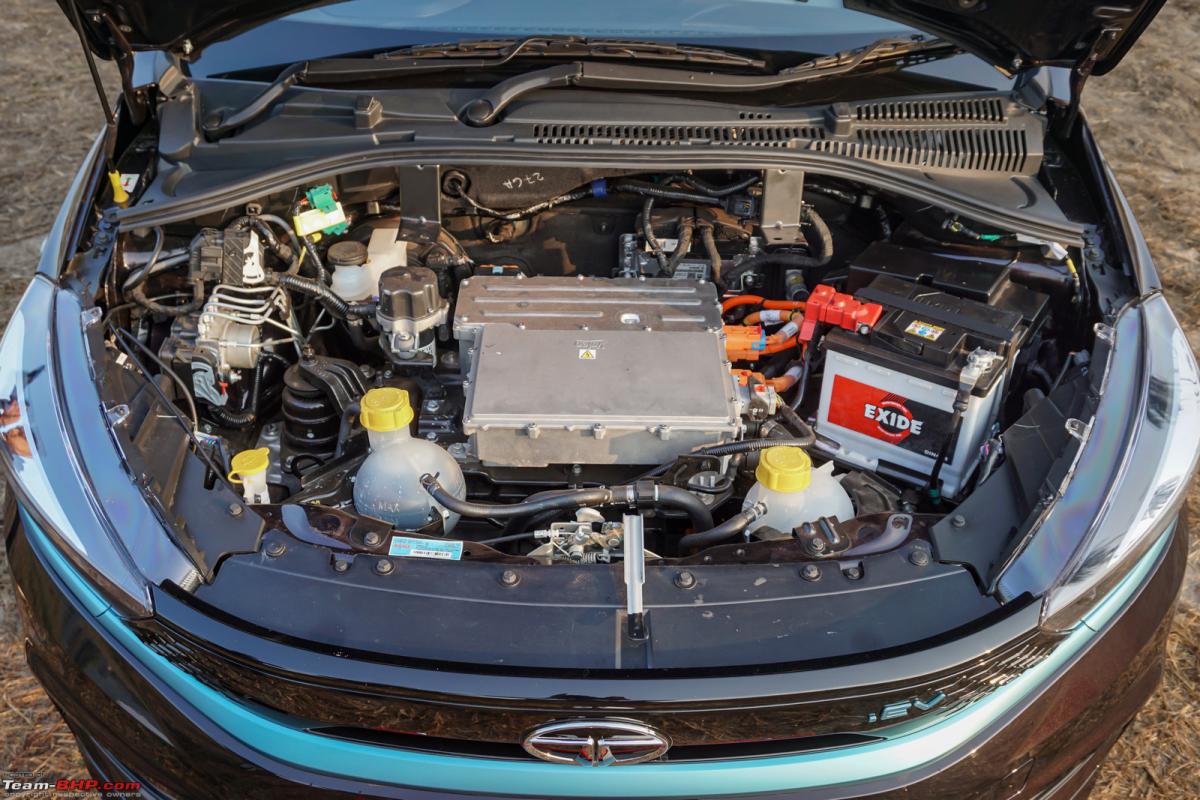
Before we get to the driving part, let’s get some basics right. There are 3 main components in an EV – the battery, the motor, and the controller/charger. The battery is what stores the energy and the motor is what uses that energy to move the car. The controller/charger converts the energy from the battery into a usable form to power the motor. In more technical terms, the power grid from your house or a charging station is usually an AC current. The lithium-ion battery can store electric energy in DC form. So while charging, there’s an AC/DC converter that will convert the power grid's AC into DC and store it in your car’s battery. The DC fast chargers that you see usually have the AC/DC converter inbuilt, which is how they can charge your car’s battery faster. The controller typically sits on top of the motor. In the case of the Tiago EV, the controller and motor are placed under the bonnet.
The Tiago EV shares its powertrain with the Tigor EV. However, there are a few differences. The torque rating is down by 56 Nm in the Tiago EV. Both have a claimed 0-60 km/h time of 5.7 seconds, despite the Tigor EV being heavier. The tuning is different on both cars and it’s worth noting that the maximum motor rpm of the Tiago EV is higher than that of the Tigor EV. Now, let’s get to the driving part. People driving an EV for the first time will need to get used to the eerie silence after pressing the start/stop button, but it takes just a couple of drives to feel comfortable with it. There are 4 transmission modes to choose from – D, R, N, and S. ‘D’ mode is more designed for city driving conditions, while ‘S’ mode is when you want that extra power (at the cost of FE, which in this case, is the battery charge level). The rotary dial for transmission modes is not very intuitive and a traditional AT gear lever with slots would’ve been preferred. Tata has integrated their recent electric cars with a useful feature to go with this rotary transmission dial. Say you’re at a traffic signal, you no longer have to switch to ‘N’ and pull the handbrake. You can just pull the handbrake in ‘D’ mode and the creep function is disengaged, so the car won’t move. Neat integration, but the customers will have to be educated about this.
As a safety feature, the car will always start in "N" mode. Engage D, take your foot off the brake pedal and the Tiago EV gets off the line in a perfectly smooth manner, crawling at 6 km/h. It’s very linear and without any jerks. Driving around in "D" mode within the city is a super convenient affair. No clutch, no gears, no turbo lag & no noise means even a newbie driver will seem like a smooth one. The motor has sufficient torque, but it is used conservatively in "D" mode for a smoother driving experience & to maximize driving range. Think of "D" being more like "ECO" mode. Performance in D mode is decent, but that's it. You won’t have any issues keeping up with city traffic & power is sufficient for day-to-day commuting. When you want to suddenly accelerate from say 40 - 50 km/h though, you will feel the power deficit & it feels like a 1.2L NA petrol! If you want quicker acceleration, simply switch to "S" mode and you’ll notice a BIG difference in the way the power is put down. The throttle response is much sharper and you get a stronger surge of power. Added bonus = in "S", you'll see the power gauge on the left showing a redline at the limit (via 3 red bars), just like a conventional rev counter.
Out on the open road, D mode is adequate for regular drivers. You can cruise comfortably on the expressway. However, if you need to execute an overtaking manoeuvre quickly, S mode comes in handy. You'll also find yourself engaging "S" mode whenever you are in the mood for some fun. The Tiago EV feels peppy in Sport mode, even on the open road. Power is delivered strongly till 100 km/h, after which it starts to taper off. The Tiago EV's top speed is limited to ~120 km/h and progress from 110 - 120 km/h is quite slow. Must add that electric cars aren't good at high-speed cruising, from the range point of view. Drive continuously at 110 - 120 km/h in "S" mode and you'll see the battery level drop alarmingly fast. That's one of the reasons you'll see most EVs driving at 80 - 90 km/h on the expressway in the middle lane. If you’re wondering, how it compares to the Tigor EV with the torque deficit, don’t worry. The Tiago EV feels very similar to drive due to the lower kerb weight (86 kg lighter) and the tuning of the motor. All in all, it is a smooth car to drive in the city and on the occasional inter-city highway trips at 80-100 km/h.
Regenerative Braking
Remember when we said Tata is updating its cars based on customer feedback? Here’s an example. The Tigor EV that we drove last year didn’t have adjustable regenerative braking. The Tiago EV gets this feature and the latest Tigor EV also has been updated with the addition of adjustable regenerative braking. Way to be proactive Tata Motors! There are 3 levels of regeneration that you can choose from. You can also turn it off completely and depend on the brakes for stopping the car. Driving with maximum level 3 regeneration, you can feel your head nod when you lift off the accelerator. It’s good for maximizing range, but not so good for smooth driving. You can switch to level 1 or 2 for smooth deceleration on lift-off. One-pedal driving is very much possible in the city with level 3 regen as the deceleration is quite strong. However, the car won't come to a complete halt. It will crawl forward and you have to apply the brakes to stop it. This is again an individual preference and we were told that depending on customer feedback, Tata will or will not make the change in the next update. This change will merely be a software update, so it can be incorporated easily.
A thoughtful integration is that in level 3 regeneration and sometimes in level 2 (if the deceleration is strong), the brake lamps light up to let the car behind know that the Tiago EV is slowing down. Another point to note is that the level 3 regeneration will not be as strong when the battery percentage is 85 and above. It’ll show that the car is on level 3, but it won’t decelerate as strongly.
Noise, Vibration & Harshness (NVH)
Well, there’s no engine noise for starters! The only sound coming is a faint whirring by the electric motor. No gearshifts & minimal mechanical parts mean no jerks or vibrations. On the highway, tyre noise starts creeping into the cabin early at 80 km/h. You'll hear it more because there is no engine sound to drown some of it out.
Range
Range anxiety is a big concern with EVs. However, it’s only when you are pushing the car hard that you'll notice the range and battery percentage falling at a rapid pace. Tata Motors claims that under standard test conditions the Tiago EV has a range of 315 km, but under normal driving conditions, you can expect a range of ~200 km. This is enough for those intending to drive primarily in the city.
The range displayed on the MID varies based on the driving style of the previous driver. So, we couldn’t depend on the range readout on our test drive. There’s another useful bit of information on the MID next to the speedometer marked as ‘AEC’ which stands for average energy consumption and has a Wh/km reading. We managed to get around 140 Wh/km with ~60% driving in S mode and 40% sedate driving with maximum regeneration. If you want to calculate what that translates to in range, just divide 24,000 (24 kWh battery capacity) by the AEC reading. In this case, we got ~171 km of range, which is not bad considering the amount of time we spent in S mode. Keep the AEC number close to 120 Wh/km and that should translate to ~200 km of range which seems doable.
Charging
Tata Motors has been working with its sister company, Tata Power, to improve the charging infrastructure levels. Also, there are multiple independent players popping up with charging stations everywhere. That said, we can tell you that the best place to charge your EV is at home. Cheapest + most convenient. At an average cost of Rs. 8 per unit, you’ll be paying Rs. 192 for a full tank at home. The estimated charging time (10% to 100%) from a 15A plug is around 8.7 hours. You can opt for the 7.2kW AC charger at your home or office for Rs 50,000 to bring down the charging time to 3.6 hours. A DC fast charger would top up the charge from 10% to 80% in just under an hour.
Suspension
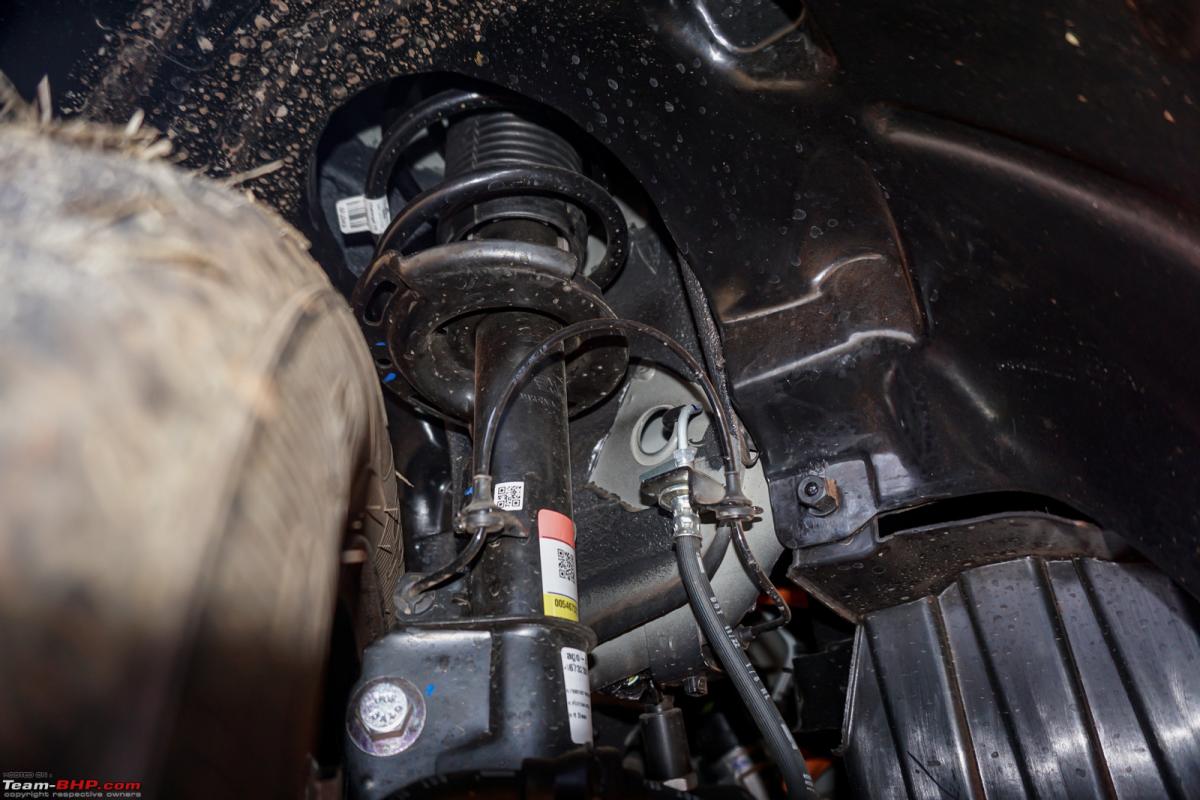
Ride Comfort
The Tiago EV gets a MacPherson strut suspension with dual-path struts at the front and a twist-beam suspension at the rear. It rides on 14-inch rims shod with 175/65 section tyres. The recommended tyre pressure rating is 33 PSI all around.
Like most fossil fuel cars converted to electric, the Tiago EV's suspension has been stiffened up due to the heavy battery pack it is carrying. You'll notice the firmer suspension as soon as you start driving the car. Over some mildly uneven roads in the city at slow speeds, there is a fair bit of movement in the cabin and it even feels jiggly at times. However, the suspension is quite absorbent at low speeds and you can carry some speed over rough roads. You feel more of the road in the Tiago EV, but still, the ride quality is liveable & compliant enough on most city roads. It's only the really big bumps that come in strong, as do the sharp road dips. On the other hand, the Tiago EV rides rather flat on the expressway. At high speeds, i.e. 100 km/h, you have to be careful of the road undulations and expansion joints.
Handling & Dynamics
There are a couple of things that aid the handling characteristics of the Tiago EV. Firstly, it’s the firmer suspension, and secondly, the heavy mechanicals (battery pack + motor) that lower the center of gravity. High-speed stability is very good and you’ll be doing 110 - 120 km/h on the expressway without feeling nervous at all.
Get on some twisty roads and you’ll appreciate the stiffer suspension. The car feels agile and you can carry good speed into corners. The suspension setup does complement the chassis well and the Tiago EV holds its line nicely. Changing direction on back-to-back corners is no problem either. You will like how the EV feels well-balanced in corners. In comparison to the Tigor EV, you don’t have the additional weight on the rear axle which is why it feels a tad bit more composed. Earlier, I had apprehensions that the heavy battery pack might cause some imbalance, but we didn't face any problem on our (admittedly) limited test drive. The only issue is the 175/65 section rubber, which is meant for maximizing range and not for pushing hard into corners. You will hear the tyres chirp when powering out of tight corners.
Steering
The electric power-assisted steering is a nice unit and is super light at parking speeds. The turning radius of 5.1 m is user-friendly and you can manoeuvre the car easily with gentle inputs on the steering. It weighs up adequately as you gain speed. It also has that typical trait in Tata’s steering where the weight is not added gradually. At ~50 km/h, you will notice that the steering wheel suddenly gets heavy. Very weird! The EPS is dead and there’s not much feel or feedback from it.
Braking
The Tiago EV gets disc brakes at the front and drum brakes at the rear. Their performance, in general, is satisfactory. However, we feel that wider tyres would definitely improve the braking performance of the car. Another sore point is that, like most EVs, the brake pedal has a spongy & rubbery feel. It feels weird at first, but you will get used to it.
Continue reading the discussion on the 2022 Tata Tiago Electric on our forum.
Pages



